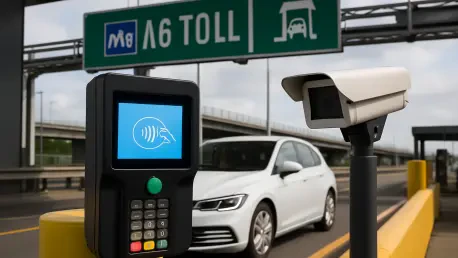The M6 Toll, the UK’s only major toll motorway, has long been a vital route for drivers looking to bypass the notorious congestion around Birmingham, often shaving up to 25 minutes off travel times. This year, a groundbreaking transformation is underway, driven by a £20 million investment from Just Group to overhaul payment systems and infrastructure. With the introduction of cutting-edge technologies like contactless payments, smartphone integrations, and automated account-based systems, the M6 Toll is setting a new standard for convenience and efficiency. These advancements are not just about keeping up with modern demands but are poised to redefine the driving experience for both individual motorists and fleet operators across the region. As these innovations roll out, they promise to address longstanding pain points like delays at toll plazas and complex payment processes, making seamless travel a reality for thousands of daily users.
1. Cutting-Edge Payment Innovations
The M6 Toll has embraced a wave of payment upgrades that prioritize speed and user experience. Early this year, a collaboration with Barclays facilitated trials of contactless payments, enabling drivers to simply tap and go at toll barriers without the need to stop and fumble for cash or cards. This system, rolled out across major plazas like Great Wyrley and Weeford, minimizes delays and enhances safety by reducing distractions. Additionally, the integration of Apple Pay and Google Pay in mid-year updates allows transactions via smartphones and smartwatches, addressing previous concerns about handling devices while driving. These advancements ensure compliance with safety regulations while offering unmatched convenience, catering to tech-savvy drivers who expect quick and intuitive solutions on the road. The shift to digital payments also reflects a broader trend in transportation infrastructure, aligning the M6 Toll with global standards for modern toll systems.
Another significant leap forward is the Breeze account system, powered by Automatic Number Plate Recognition (ANPR) technology. This setup lets registered vehicles pass through dedicated lanes without stopping, as payments are automatically deducted from linked accounts. Drivers using Breeze can enjoy discounts of up to 37 percent compared to standard rates, providing a cost-effective alternative for frequent users. Fleet operators, in particular, benefit from expanded ANPR integrations with partners like Maritime and Keyfuels, which streamline processing through contactless terminals. A £20 million refinancing deal announced mid-year is funding these upgrades, alongside improvements to toll plazas and infrastructure, ensuring minimal disruption even as major projects like the M54-M6 link road construction continue. This focus on automation and efficiency marks a pivotal moment for the M6 Toll, setting it apart as a leader in toll road innovation.
2. Simplified Payment Processes for All
Navigating the payment system on the M6 Toll has become entirely cashless, relying on electronic methods at key locations. At the primary plazas, drivers can use debit or credit cards, including American Express, or opt for mobile payment options like Apple Pay and Google Pay. Smaller plazas at junctions T3 to T6 operate similarly, ensuring consistency across the network. For those who miss a payment, an assistance button at the plaza provides a Payment Notice, granting six days to settle online and avoid a £70 fine. This user-friendly approach reduces stress for occasional users while maintaining strict enforcement to ensure fairness. The emphasis on digital transactions eliminates the hassle of carrying cash, aligning with the growing preference for contactless solutions in everyday life and making the toll road accessible to a wider audience.
Beyond immediate payments, the option to pre-pay through the Breeze account or online portal offers a seamless alternative. Drivers can register their vehicles, link a funding source, and let ANPR handle the rest, effectively eliminating wait times at barriers. The system supports up to five vehicles per account and provides online statements for expense tracking, a boon for both individuals and businesses. Discounts are also available for heavy goods vehicles and fleets using tags, though ANPR is gaining traction as the preferred method. Exemptions for disabled drivers receiving specific benefits and emergency vehicles further demonstrate a commitment to inclusivity. These streamlined processes not only save time but also reduce the cognitive load on drivers, allowing them to focus on the road rather than payment logistics, a critical factor in enhancing overall safety.
3. Cost Structures and Travel Optimization
Understanding the toll costs on the M6 Toll is essential for drivers planning their journeys, as pricing varies by vehicle type and distance traveled across three distinct zones. A full three-zone trip currently costs £10.30 for cars, £17.30 for vans, and £17.90 for heavy goods vehicles, with motorcycles at £5 and cars with trailers at £14.70. Two-zone and single-zone trips are proportionally cheaper, offering flexibility for shorter routes. Unlike some toll systems, pricing remains consistent regardless of the time of day, though Breeze account holders benefit from significant savings. Recent debates over vehicle classifications, especially for luxury MPVs and airport transfers, highlight the importance of verifying axle and height details to avoid unexpected charges. This transparent yet nuanced cost structure ensures fairness while encouraging drivers to leverage account-based discounts for maximum value.
For those aiming to optimize their travel, strategic planning can make a substantial difference in both cost and time savings. Route planners like Google Maps help identify the most efficient paths, balancing the expense of tolls against the time saved compared to congested alternatives like the standard M6. The M6 Toll also offers midway service areas for refueling and rest, providing a more comfortable experience than busier motorways. Staying updated through official channels ensures drivers are aware of the latest payment technologies and infrastructure changes, especially as ANPR adoption and system integrations expand. These practical tips empower motorists to make informed decisions, turning what could be a stressful journey into a smooth and predictable one. The combination of modern tech and actionable travel advice positions the M6 Toll as a model for toll road efficiency.
4. Looking Ahead: The Road to Seamless Travel
Reflecting on the strides made, the M6 Toll has embarked on a transformative journey with payment technologies that redefine convenience for drivers. The rollout of contactless payments, mobile integrations, and ANPR-driven systems has addressed critical bottlenecks, ensuring smoother transitions at toll plazas. Investments in infrastructure have minimized disruptions, even amidst large-scale projects, proving that modernization and user experience can coexist. These efforts have set a benchmark for other toll roads, demonstrating how technology can alleviate congestion and enhance safety. The impact on daily commuters and fleet operators alike has been profound, marking a shift toward a more connected and efficient driving landscape.
Moving forward, the focus should remain on expanding these innovations to cover more aspects of the toll experience, such as real-time traffic updates integrated with payment apps. Stakeholders must continue to prioritize user education, ensuring drivers fully understand the benefits of systems like Breeze to maximize adoption. Exploring further partnerships with tech providers could introduce predictive analytics for toll pricing or congestion management, offering even greater value. As the M6 Toll evolves, maintaining a balance between technological advancement and accessibility will be key to sustaining its role as a pioneer in motorway travel. These next steps promise to build on the foundation laid, paving the way for a future where driving is not just faster, but smarter.









